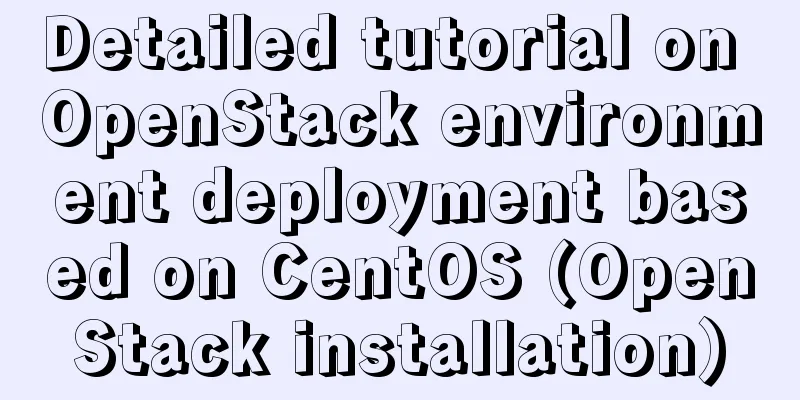How to use docker to deploy Django technology stack project

|
With the popularity and maturity of Docker, it has gradually become the first choice for deploying projects. Today I will share with you how to use docker to deploy Django technology stack projects. The Django technology stack we are talking about here is: python3.6, Django2.2, redis, mysql, celery, gunicorn and nginx. In actual production projects, these components are distributed on different machines in the cluster. For example, Nginx, redis, and Mysql may be managed by separate teams or departments. The deployment architecture and container orchestration involved are more complex and will not be explored in depth in this article. This article mainly introduces how to use docker-compose to orchestrate these components. This method is suitable for the deployment of test environment or your personal sideproject. This article assumes that you already know some basic knowledge of docker and docker-compose. If you don’t, you can read the following materials:
Let's talk about how to deploy it. Project Organizational Structure First, let's take a look at our project organizational structure, which is as follows: ├── LICENSE ├── README.md ├── compose │ ├── celery │ │ ├── Dockerfile │ │ ├── celery-beat.sh │ │ └── celery.sh │ ├── mysql │ │ └── my.cnf │ ├── nginx │ │ └── nginx.conf │ └── web │ ├── Dockerfile │ ├── entrypoint.sh │ ├── gunicorn.conf │ └── gunicorn.sh ├── docker-compose.yml ├── docker_django_demo │ ├── __init__.py │ ├── celery.py │ ├── settings.py │ ├── urls.py │ └── wsgi.py ├── env.tpl ├── manage.py ├── requirements.txt In addition to the Django project files, the main additions are the compose configuration file directory and the docker-compose.yml configuration file.
Write Dockerfile and start initialization script In docker-compose, there are two ways to start the container. One is to directly use a public image to start the container, and the other is to use a Dockerfile written by ourselves. Because we need to install additional toolkits and initialize related configurations, we use a custom Dockerfile for the web and celery components. compose/web/Dockerfile for the web container: FROM python:3.6 ENV PYTHONUNBUFFERED 1 RUN mkdir /code WORKDIR /code COPY ./requirements.txt /code/ RUN pip install --no-cache-dir -r requirements.txt \ && rm -rf requirements.txt COPY ./code/ COPY ./compose/web/*.sh /code/ RUN sed -i 's/\r//' gunicorn.sh \ && chmod +x gunicorn.sh \ && sed -i 's/\r//' entrypoint.sh \ && chmod +x entrypoint.sh ENTRYPOINT ["/bin/bash", "entrypoint.sh"] Other files of the web container:
Dockerfile for celery: FROM python:3.6 ENV PYTHONUNBUFFERED 1 RUN mkdir /code WORKDIR /code COPY ./requirements.txt /code/ COPY ./compose/celery/*.sh /code/ RUN pip install --no-cache-dir -r requirements.txt \ && rm -rf requirements.txt && sh init_env.sh COPY ./code/ COPY ./compose/celery/*.sh /code/ RUN sed -i 's/\r//' celery.sh \ && chmod +x celery.sh \ && sed -i 's/\r//' celery-beat.sh \ && chmod +x celery-beat.sh Other files of celery:
Write the Compose startup configuration file The docker-compose configuration is as follows: version: '2' services: redis: image: redis ports: - "6379:6379" db: restart: always image:mysql:5.7.19 # command: --character-set-server=utf8mb4 --collation-server=utf8mb4_unicode_ci volumes: - ./compose/mysql/:/etc/mysql/conf.d - ./db:/var/lib/mysql # for test ports: - "127.0.0.1:3307:3306" # (HOST:CONTAINER) env_file: - .env web: # restart: always build: context: . dockerfile: ./compose/web/Dockerfile command: sh gunicorn.sh # ["/bin/bash", "gunicorn.sh"] ports: - "8080:8002" # (HOST:CONTAINER) volumes: - ./logs:/var/logs/ - ./collect_static:/code/collect_static - ./static:/code/static - ./templates:/code/templates - ./uploads:/code/uploads env_file: .env depends_on: - redis -db nginx: restart: always image: nginx:1.13.0 volumes: - ./compose/nginx:/etc/nginx/conf.d/ - ./staticfiles:/code/staticfiles - ./logs:/var/log/nginx ports: - "80:80" # (HOST:CONTAINER) depends_on: - web celery: build: context: . dockerfile: ./compose/celery/Dockerfile command: sh celery.sh volumes: - ./logs:/var/logs/ - ./uploads:/code/uploads depends_on: - redis -db env_file: .env celery-beat: build: context: . dockerfile: ./compose/celery/Dockerfile command: sh celery-beat.sh volumes: - ./logs:/var/logs/ depends_on: - redis -db env_file: .env Celery worker and beat Here we use the same image Dockerfile. According to the principle of one image and one process, we start two containers to run the worker and beat processes respectively. Compile test After writing the configuration file, compile the image and test it: docker-compose build docker-compose up # Run in the foreground docker-compose up -d # Run in the background after everything is correct docker-compose ps You can see the started container:
$ docker-compose ps
Name Command State Ports
--------------------------------------------------------------------------------------------------
docker djangodemo_celery-beat_1 sh celery-beat.sh Up
docker djangodemo_celery_1 sh celery.sh Up
dockerdjangodemo_db_1 docker-entrypoint.sh mysqld Up 127.0.0.1:3307->3306/tcp
dockerdjangodemo_nginx_1 nginx -g daemon off; Up 0.0.0.0:80->80/tcp
dockerdjangodemo_redis_1 docker-entrypoint.sh redis ... Up 0.0.0.0:6379->6379/tcp
dockerdjangodemo_web_1 /bin/bash entrypoint.sh sh ... Up 0.0.0.0:8080->8002/tcp
The mapping port can be adjusted according to your actual situation. question Here are a few issues that need attention during the construction process. mysql encoding problem The default encoding of the MySQL image provided by Docker is latin1, which will display garbled characters when saving Chinese. The official website provides a method to modify the encoding method. You can specify the encoding format after starting the script. The document can be found here. For MySQL container version 5.7.19, you can add the parameters --character-set-server=utf8mb4 --collation-server=utf8mb4_general_ci directly after command in docker-compose.yml. This method only modifies the encoding on the server side. You can directly use the configuration file to override and specify all encoding formats. The configuration is as follows: [mysqld] default-storage-engine=INNODB character-set-server=utf8mb4 collation-server=utf8mb4_general_ci init-connect='SET NAMES utf8mb4' init_connect = 'SET collation_connection = utf8mb4_general_ci' skip-character-set-client-handshake # Skip the client encoding configuration, and the client directly uses the server encoding configuration bind-address = 0.0.0.0 Note: The configuration file method of MySQL 5.7.19 succeeds, while 5.7.4 and 5.7.17 fail. You can use this as a reference. Web waits for MySQL to start before continuing The mysql container cannot accept database links before it is started. When the web is initialized, if the database has not been started yet, the web container will fail to start and exit directly. We can add a detection script when the web container is started, and then continue after the database is connected. The script is as follows:
#!/usr/bin/env bash
set -o errexit
set -o pipefail
echo $MYSQL_PASSWORD
echo $MYSQL_DATABASE
echo $MYSQL_HOST
echo $MYSQL_USER
echo $MYSQL_PORT
function mysql_ready(){
python << END
import sys
import pymysql
try:
conn = pymysql.connect(host="db", port=3306, user="root", passwd="$MYSQL_ROOT_PASSWORD", db='$MYSQL_DATABASE', charset='utf8')
except pymysql.err.OperationalError:
sys.exit(-1)
sys.exit(0)
END
}
until mysql_ready; do
>&2 echo "MySQL is unavailable - sleeping"
sleep 1
done
>&2 echo "MySQL is up - continuing..."
Summarize At this point, the deployment of the Django technology stack service using Docker is complete. For the complete project code, you can refer to docker-django-demo. As mentioned at the beginning of the article, this deployment method is not suitable for online production services of large websites. It has many problems such as high coupling and poor maintenance. However, deploying your own sideproject or test environment is still very good when hardware resources are limited. In addition to reducing the trouble of environment deployment and setup, it is also very convenient to migrate. The demo project also has some examples of how to use docker in a development environment, but I personally think that docker is more suitable for deployment, and it is not as flexible and convenient as building it directly in a development environment. Welcome everyone to leave a message and discuss the experience of using Docker in development and deployment. refer to cookiecutter-django The above is the full content of this article. I hope it will be helpful for everyone’s study. I also hope that everyone will support 123WORDPRESS.COM. You may also be interested in:
|
<<: Solution to the problem that MySql always pops up the mySqlInstallerConsole window
>>: Vue implements setting multiple countdowns at the same time
Recommend
How to use fdisk to partition disk in Linux
Commonly used commands for Linux partitions: fdis...
Windows Server 2008 Tutorial on Monitoring Server Performance
Next, we will learn how to monitor server perform...
MySQL Query Cache and Buffer Pool
1. Caches - Query Cache The following figure is p...
How to authorize remote connections in MySQL in Linux
Note: Other machines (IP) cannot connect to the M...
Example of customizing the style of the form file selection box
Copy code The code is as follows: <!DOCTYPE ht...
MySQL deduplication methods
MySQL deduplication methods 【Beginner】There are v...
Detailed steps to configure my.ini for mysql5.7 and above
There is no data directory, my-default.ini and my...
MySQL 5.6 decompressed version service cannot be started due to system error 1067
Record the BUG that got me stuck all afternoon to...
JavaScript data type conversion example (converting other types to strings, numeric types, and Boolean types)
Preface What is data type conversion? The default...
Use of MySQL triggers
Triggers can cause other SQL code to run before o...
MySQL online log library migration example
Let me tell you about a recent case. A game log l...
Detailed explanation of top command output in Linux
Preface I believe everyone has used the top comma...
JavaScript to achieve fixed sidebar
Use javascript to implement a fixed sidebar, for ...
5 ways to achieve the diagonal header effect in the table
Everyone must be familiar with table. We often en...
Alibaba Cloud domain name and IP binding steps and methods
1 Enter the Alibaba Cloud console, find the domai...









